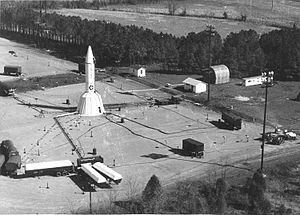This article includes a list of general references, but it lacks sufficient corresponding inline citations. (November 2020) |
| SM-78/PGM-19 Jupiter | |
|---|---|
 Jupiter missile emplacement showing ground support equipment. The bottom third of the missile is encased in a "flower petal shelter" of wedge-shaped metal panels allowing crews to service the missile in all weather conditions. | |
| Type | Medium-range ballistic missile (MRBM) |
| Place of origin | United States |
| Service history | |
| Used by | United States Air Force Italian Air Force Turkish Air Force |
| Production history | |
| Designed | 1954 |
| Manufacturer | Chrysler |
| Produced | 1956–1961 |
| No. built | approx. 100 (45 deployed) |
| Variants | Juno II |
| Specifications | |
| Mass | (110,000 lb) 49,800 kg |
| Length | (60 ft) 18.3 m |
| Diameter | (8 ft 9 in) 2.67 m |
| Warhead | W38 warhead 3.75 Mt or W49 1.44 Mt |
| Blast yield | 3.75 Mt or 1.44 Mt |
| Engine | Rocketdyne LR79-NA (Model S-3D) liquid LRE 150,000 lbf (667 kN) |
| Propellant | kerosene and liquid oxygen |
Operational range | 1,500–1,700 miles (2,400–2,700 km) |
| Flight ceiling | 380 mi (610 km) |
The PGM-19 Jupiter was the first nuclear armed, medium-range ballistic missile (MRBM) of the United States Air Force (USAF). It was a liquid-propellant rocket using RP-1 fuel and LOX oxidizer, with a single Rocketdyne LR79-NA (model S-3D) rocket engine producing 667 kilonewtons (150,000 lbf) of thrust. It was armed with the 1.44 megatons of TNT (6.0 PJ) W49 nuclear warhead. The prime contractor was the Chrysler Corporation.
The Jupiter was originally designed by the US Army, which was looking for a highly accurate missile designed to strike enemy states such as China and the Soviet Union. The US Navy also expressed an interest in the design as an SLBM but left the collaboration to work on their solid-fuel Polaris. Jupiter retained the short, squat shape intended to fit in submarines.